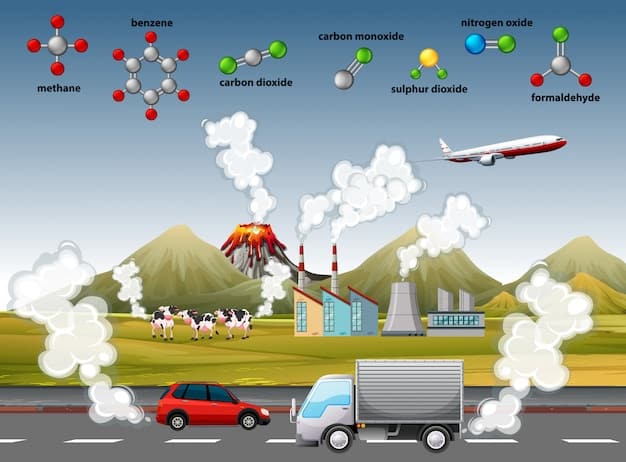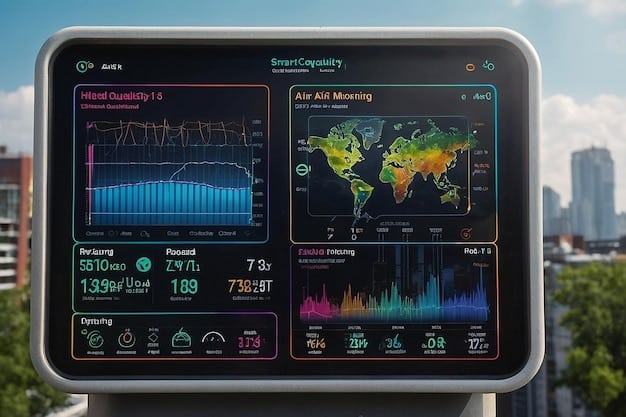Clean Air Act Amendments: Business Impact in US

Proposed amendments to the Clean Air Act signal significant shifts for US businesses, necessitating a proactive understanding of potential compliance changes, operational costs, and investment opportunities in sustainable practices to mitigate environmental impact.
For US businesses, understanding the proposed amendments to the Clean Air Act is not merely a regulatory exercise; it is a critical strategic imperative that could redefine operational landscapes, compliance requirements, and future investment trajectories. Staying informed about these potential changes is paramount.
The Clean Air Act: A Foundation for Environmental Stewardship
The Clean Air Act (CAA) stands as a landmark piece of US environmental legislation, enacted to control air pollution nationwide. Its broad scope covers everything from emissions from stationary sources like factories to mobile sources such as vehicles. Since its inception, the CAA has undergone various amendments, reflecting evolving scientific understanding of pollution, technological advancements, and shifting societal priorities regarding environmental protection. Each amendment aims to strengthen air quality standards and enhance the enforcement mechanisms.
The core objective of the CAA is to protect public health and welfare from diverse types of air pollution. It mandates the Environmental Protection Agency (EPA) to set National Ambient Air Quality Standards (NAAQS) for critical pollutants, requiring states to develop plans to meet these standards. Beyond NAAQS, the Act regulates hazardous air pollutants (HAPs), sets emissions standards for new and existing sources, and addresses issues like stratospheric ozone protection and acid rain. Its comprehensive nature makes any proposed alteration a matter of significant interest across various sectors.
Understanding the historical context of the CAA is vital to appreciating the potential impact of new amendments. It has driven significant improvements in air quality over decades, leading to reduced respiratory illnesses, increased agricultural yields, and improved visibility. However, economic growth and new scientific discoveries continually present challenges that necessitate refinements to the Act. The proposed amendments often arise from a combination of these factors, seeking to address both persistent and emerging air quality concerns through updated regulatory frameworks and technological mandates.
The Act’s structure allows for various regulatory tools, from “command and control” approaches that set specific limits to market-based mechanisms like emissions trading. This flexibility enables the EPA to adapt its strategies to different types of pollution and sources. Businesses, in turn, have had to adapt to these evolving regulatory demands, often investing in new pollution control technologies or altering manufacturing processes. The CAA also fosters public participation and transparency, allowing stakeholders to comment on proposed rules and ensuring a degree of accountability in environmental governance. This multi-faceted approach underscores the complexity and importance of any discussions surrounding its future.
Key Provisions of the Current Clean Air Act
The existing Clean Air Act is built upon several foundational pillars:
- National Ambient Air Quality Standards (NAAQS): Set for six common pollutants (ozone, particulate matter, carbon monoxide, sulfur dioxide, nitrogen dioxide, and lead) to protect public health and welfare.
- National Emission Standards for Hazardous Air Pollutants (NESHAPs): Regulate emissions of toxic air pollutants from specific industrial sources.
- New Source Review (NSR): Requires industrial facilities to obtain permits before constructing new plants or making major modifications to existing ones, ensuring the use of best available control technology.
- Mobile Source Emissions: Controls emissions from cars, trucks, buses, and other vehicles through fuel efficiency standards and emissions limits for manufacturers.
These provisions collectively form the backbone of US air quality management, influencing everything from urban planning to industrial operations. Compliance with these regulations is a significant driver of corporate environmental spending and technological innovation.

Decoding the Proposed Amendments: Key Areas of Focus
Recent discussions surrounding proposed amendments to the Clean Air Act point toward several critical areas of focus, each with significant implications for US businesses. These amendments are often driven by new scientific data, technological advancements, and evolving policy priorities related to climate change and environmental justice. Understanding these specific areas is crucial for businesses to assess their potential exposure and prepare for future compliance requirements.
One prominent area of proposed change often centers on strengthening emission standards for industrial sources. This might involve lowering permissible limits for specific pollutants, or expanding the list of regulated substances, particularly those linked to public health concerns or climate impacts. Such changes typically necessitate substantial investments in new pollution control technology or process modifications for affected industries, potentially raising operational costs but also spurring innovation in green technologies. New monitoring and reporting requirements might also accompany tighter standards, increasing administrative burdens but enhancing data transparency.
Another significant focus could be on integrating climate change considerations more explicitly into the CAA. While the Act has historically addressed air pollutants, its direct application to greenhouse gases has been a subject of ongoing legal and political debate. Proposed amendments might seek to clarify the EPA’s authority in regulating carbon dioxide, methane, and other potent greenhouse gases. This could involve setting sector-specific emission reduction targets, implementing carbon pricing mechanisms, or introducing new permitting requirements for activities that significantly contribute to climate change. Such shifts would profoundly impact energy-intensive industries and those reliant on fossil fuels, accelerating the transition towards cleaner energy sources and more sustainable industrial practices.
Furthermore, amendments might address environmental justice concerns, aiming to reduce disproportionate pollution burdens on disadvantaged communities. This could manifest as stricter permitting requirements for new facilities in overburdened areas, enhanced monitoring in these regions, or mandates for community engagement in regulatory decision-making. Businesses planning expansion or new developments would need to undertake more rigorous environmental impact assessments and engage proactively with local communities, potentially delaying projects or increasing upfront investment in mitigation strategies designed to benefit proximate populations. This focus emphasizes the social dimension of environmental regulation.
Changes related to mobile source emissions are also frequently on the agenda. This could involve accelerated timelines for vehicle emissions standards, mandates for electric vehicle adoption, or new regulations concerning emissions from heavy-duty vehicles and non-road engines. For automotive manufacturers, this would mean significant R&D investments in zero-emission technologies. For logistics and transportation companies, it would necessitate fleet modernization and infrastructure development for charging or alternative fuels. These changes aim to capitalize on technological progress and reduce urban air pollution, but also present substantial capital demands for businesses in these sectors.
Anticipated Changes in Regulatory Frameworks
The proposed amendments often bring with them fundamental shifts in how regulations are structured and enforced. Businesses should anticipate changes like:
- Stricter Enforcement Mechanisms: Increased penalties for non-compliance, more frequent inspections, and enhanced monitoring requirements.
- Sector-Specific Regulations: Tailored rules for industries with high emissions, such as power generation, manufacturing, and transportation, potentially requiring specialized compliance strategies.
- New Permitting Requirements: Revised or entirely new permitting processes for certain activities, possibly involving more stringent environmental impact assessments.
- Emphasis on Climate Resilience: Regulations that link air quality improvements with broader climate resilience goals, encouraging investments in renewable energy and green infrastructure.
These framework modifications are designed to achieve environmental goals more effectively but will undoubtedly necessitate internal operational adjustments and potentially new compliance departments within corporations.
Potential Impacts on US Businesses Across Sectors
The reverberations of proposed Clean Air Act amendments would be felt across the entire spectrum of US businesses, albeit with varying degrees of intensity depending on individual sector characteristics and current operational practices. For some, the changes could present significant challenges and increased costs, while for others, they might unlock new market opportunities and competitive advantages. Businesses that have already invested in sustainable practices or possess adaptable infrastructures may find themselves better positioned to navigate the transition, whereas those heavily reliant on traditional, high-emission processes could face more substantial hurdles.
In the energy sector, particularly for coal and natural gas power generation, tighter emission standards for criteria pollutants and greenhouse gases would lead to intensified pressure to adopt carbon capture technologies, transition to renewable energy sources, or retire older facilities. This would accelerate the ongoing transformation of the grid, influencing investment decisions in new power plants and grid infrastructure. Companies engaged in oil and gas extraction might face new regulations concerning methane emissions from wells and pipelines, requiring enhanced leak detection and repair programs. Such changes inherently reshape the economics of fossil fuel production and utilization.
The manufacturing sector, especially heavy industries like steel, cement, and chemicals, would likely confront revised New Source Review (NSR) thresholds and stricter emission limits. This could necessitate substantial capital expenditures for pollution control equipment, adoption of cleaner production technologies, and potentially redesigning manufacturing processes to reduce their environmental footprint. While challenging, this push could also stimulate innovation in materials science and process engineering, leading to more efficient and less polluting industrial practices, potentially enhancing global competitiveness for forward-thinking firms. Smaller manufacturers might require government assistance or revised timelines to comply.
For the transportation and logistics sectors, proposed amendments often target vehicle emissions and fuel standards. This might translate into accelerated mandates for electric or hydrogen-powered vehicle fleets, investments in charging or refueling infrastructure, and potentially higher costs for conventional fuels due to stricter refinery standards. Automotive manufacturers would undoubtedly intensify their focus on developing advanced vehicle technologies, while logistics companies would need to strategically plan fleet renewals and route optimizations to minimize emissions. The ripple effect could extend to urban planning and public transit as well, promoting multimodal transportation solutions.
Even sectors seemingly less directly involved, such as agriculture, could experience indirect effects. Regulations targeting methane from livestock or nitrous oxide from fertilizer use could emerge, prompting shifts towards more sustainable farming practices and land management. The real estate and construction industries might see increased demand for energy-efficient buildings and materials that have a lower embodied carbon footprint, driven by broader climate-related regulatory pressures. The financial sector, in turn, would need to assess environmental risks more rigorously in lending and investment decisions, factoring in companies’ compliance burdens and transition pathways.
Sector-Specific Challenges and Opportunities
- Energy Production: Increased pressure to decarbonize, driving investment in renewables and carbon capture; potential operational cost increases for fossil fuel plants.
- Manufacturing: Need for significant capital expenditure on new pollution control tech; opportunities for innovation in green manufacturing processes.
- Transportation: Accelerated transition to electric/alternative fuel vehicles; new infrastructure requirements for charging/fueling.
- Agriculture: Potential regulations on methane and nitrous oxide, fostering sustainable farming practices.
- Real Estate & Construction: Increased demand for green buildings and sustainable materials.
Across all sectors, the fundamental challenge lies in adapting existing business models to a more environmentally stringent regulatory environment. However, this adaptation also creates significant opportunities for companies that innovate, embrace sustainability, and anticipate regulatory changes to gain a competitive edge.
Compliance Strategies for Businesses: Navigating the New Landscape
As proposed amendments to the Clean Air Act inevitably reshape the regulatory landscape, US businesses must proactively develop robust compliance strategies. Merely reacting to new rules as they are implemented is a recipe for increased costs, potential penalties, and impaired public reputation. A forward-looking approach involves meticulous planning, investment in relevant technologies, and a deep understanding of evolving legal and technical requirements. The sophistication of these strategies will often determine a company’s ability to maintain competitiveness and operational continuity in a more environmentally conscious economy.
One foundational strategy involves conducting a comprehensive internal audit of current emissions and operational processes against anticipated new standards. This “gap analysis” helps identify areas of non-compliance well in advance, allowing for phased improvements rather than last-minute overhauls. Businesses should engage technical experts—environmental engineers, legal counsel specializing in environmental law, and sustainability consultants—to help interpret complex regulatory language and translate it into actionable internal policies. This ensures that compliance efforts are both effective and legally sound, minimizing future liabilities.
Investment in advanced pollution control technologies is often a direct consequence of tighter emission limits. This could range from upgrading existing scrubber systems and catalytic converters to adopting entirely new production methods that inherently generate fewer pollutants. For carbon-intensive industries, this might mean exploring carbon capture, utilization, and storage (CCUS) technologies, or investing in renewable energy sources to power operations. While these investments can be substantial initially, they frequently lead to long-term operational efficiencies, reduced energy consumption, and often provide a hedge against future, even stricter, regulations.

Beyond technological upgrades, operational adjustments are equally crucial. Businesses may need to revise their supply chain management to source materials with lower environmental footprints, optimize transportation logistics to reduce fuel consumption, or implement industrial symbiosis practices where waste from one process becomes a valuable input for another. Employee training programs will also be vital to ensure that operational staff understand and adhere to new procedures and protocols, fostering a culture of environmental responsibility at all levels of the organization. This holistic approach ensures that compliance is embedded into day-to-day operations.
Engaging with regulatory bodies and industry associations is another critical component of a proactive compliance strategy. Participating in public comment periods for proposed rules allows businesses to provide valuable industry-specific insights, potentially influencing the final shape of regulations and ensuring they are practical and achievable. Collaborating with industry peers on best practices and shared compliance challenges can also provide communal learning and influence the development of more effective and economically sensible solutions. This collective engagement ensures that business perspectives are heard and considered in policy formulation.
Best Practices for Proactive Compliance
- Early Adoption of Technology: Invest in next-generation pollution control and monitoring equipment before it becomes mandated.
- Supply Chain Assessment: Evaluate and optimize your supply chain for lower emissions and sustainable inputs.
- Employee Training and Awareness: Implement comprehensive programs to educate staff on new regulations and procedures.
- Continuous Monitoring and Reporting: Establish robust systems for real-time emissions monitoring and accurate reporting to regulatory agencies.
- Strategic Partnerships: Collaborate with environmental consultants, legal experts, and technology providers to navigate complex requirements.
Ultimately, a robust compliance strategy is less about meeting minimum requirements and more about integrating environmental stewardship into core business operations, transforming regulatory burdens into opportunities for sustainable growth.
Economic Implications: Costs, Investments, and Market Shifts
The economic implications of proposed Clean Air Act amendments are multifaceted, encompassing expected increases in operational costs, the necessity for strategic investments, and potential shifts within market dynamics. While the primary goal of these amendments is environmental protection, their economic ripple effects are undeniable and often dictate the pace and nature of corporate adaptation. Understanding these financial dimensions is essential for businesses to accurately forecast expenditures, secure necessary funding, and maintain profitability in a transforming regulatory environment.
Initially, businesses, particularly those in emission-intensive sectors, should anticipate an increase in compliance costs. This includes expenses associated with installing and maintaining advanced pollution control equipment, purchasing emissions allowances if cap-and-trade systems are expanded, and potentially higher energy costs if cleaner energy sources are mandated but come at a premium. There will also be administrative costs for enhanced monitoring, reporting, and permit applications. For some businesses, these direct costs might necessitate price adjustments for their products or services, which could impact consumer demand or competitive positioning within their respective markets.
However, these costs are often balanced by significant opportunities for strategic investment, which can yield long-term economic benefits. Investments in energy efficiency, for instance, not only reduce emissions but also lower operational expenses through decreased energy consumption. Transitioning to renewable energy sources can provide long-term price stability for energy inputs, insulating businesses from volatile fossil fuel markets. Furthermore, investing in research and development for cleaner technologies can position companies as leaders in emerging green markets, attracting environmentally conscious consumers and investors, and potentially opening up new revenue streams that diversify their business portfolio.
The amendments are likely to catalyze substantial market shifts, favoring industries and companies that demonstrate strong environmental performance and innovation. Businesses that proactively adopt sustainable practices and develop eco-friendly products may gain a competitive advantage over those slower to adapt. This could lead to increased market share, enhanced brand reputation, and improved access to “green finance”—capital specifically allocated for environmentally sound investments. Conversely, companies failing to adapt might face decreased demand, divestment from socially responsible investors, and increased difficulty in securing loans, potentially leading to market contraction.
Moreover, the proposed amendments could foster job creation in sectors related to environmental technology, renewable energy infrastructure, and compliance services. As businesses invest in new equipment and processes, demand for engineers, technicians, and environmental consultants will likely increase. This economic stimulus in green industries can partially offset costs in traditional, high-emission sectors, contributing to a broader economic transition towards sustainability. The long-term economic benefits also include reduced healthcare costs from improved air quality and increased productivity due to a healthier workforce, though these benefits are often diffuse and harder to quantify at the individual business level.
Investment Opportunities and Challenges
- Challenges: Increased capital expenditure for new technology; potential for higher operating costs; risk of stranded assets for non-compliant infrastructure.
- Opportunities: Access to green finance and tax incentives; creation of new green product lines and services; enhanced brand reputation and market differentiation.
- Job Growth: Demand for environmental engineers, renewable energy technicians, and sustainability experts.
- Market Reallocation: Shift of investment and consumer preference towards sustainable businesses and products.
Thus, while the immediate financial burden of compliance can be significant, the amendments also act as a powerful catalyst for innovation, efficiency, and the redistribution of capital towards more sustainable economic activities.
Advocacy and Engagement: Influencing Regulatory Outcomes
For US businesses, particularly those that anticipate significant impacts from proposed Clean Air Act amendments, active advocacy and strategic engagement with policymakers and regulatory bodies are not just options—they are essential. Influencing the regulatory outcome, or at least ensuring that business concerns are adequately heard and considered, can mitigate potential adverse effects and help shape a more balanced and practical policy framework. Simply waiting for new rules to be enacted leaves little room for responsive adaptation, whereas proactive participation can often lead to more equitable and economically viable regulations.
One of the most direct avenues for engagement is participating in the public comment periods mandated for proposed rules. When the Environmental Protection Agency (EPA) or other relevant bodies publish a notice of proposed rulemaking, there is a designated window for stakeholders to submit written comments. Businesses should leverage this opportunity to provide data-driven feedback on the feasibility, costs, and benefits of proposed provisions. This includes offering specific technical insights on how new standards might impact operations, proposing alternative compliance pathways, and highlighting unintended consequences that policymakers might not have foreseen. Well-reasoned, data-supported comments can genuinely influence the final rule. Engaging expert consultants to assist in drafting these comments ensures they are technically robust and strategically presented.
Beyond individual comments, businesses can amplify their voice by engaging with industry trade associations. These associations often represent a collective interest, pooling resources and expertise to lobby effectively on behalf of their members. They can convene diverse stakeholders, commission economic impact studies, and present a unified front to policymakers. Membership in such groups allows businesses to stay abreast of legislative developments, participate in shaping industry positions, and contribute to broader advocacy efforts that might be beyond the scope of individual company resources. These associations frequently have established relationships with legislative staff and agency officials, facilitating more direct lines of communication.
Direct lobbying efforts, while often controversial, are a legitimate component of influencing policy. This involves engaging professional lobbyists to communicate specific business concerns directly to members of Congress, their staff, and high-ranking agency officials. The aim is to educate policymakers about the practical realities of implementing new regulations and to advocate for policies that balance environmental protection with economic viability. Such efforts often focus on providing technical information, economic impact assessments, and suggesting flexible compliance mechanisms that achieve environmental goals without unduly burdening specific industries. Transparency in these activities is often required by law.
Cultivating relationships with local and state elected officials is also important, as state-level environmental regulations often complement or precede federal ones. Local officials can be powerful advocates for their constituents’ businesses within wider legislative debates. Furthermore, engaging in public awareness campaigns, contributing to think tanks, or supporting academic research related to environmental policy can help shape public opinion and provide a broader context for policy discussions. This multifaceted approach ensures that business perspectives are integrated into various levels of the policy-making process.
Effective Engagement Strategies
- Submit Thoughtful Public Comments: Provide detailed, data-backed feedback on proposed rules during official comment periods.
- Join Industry Associations: Leverage collective lobbying power, share insights, and stay informed on policy developments.
- Direct Lobbying: Engage with elected officials and their staff to explain business impacts and propose practical solutions.
- Build Coalitions: Partner with other businesses, NGOs, and community groups to advocate for shared interests.
- Monitor Legislative Developments: Stay continuously updated on new bills, hearings, and regulatory announcements.
By actively participating in policy discussions, businesses can protect their interests, contribute to more effective environmental governance, and foster regulations that are both environmentally sound and economically sustainable.
Future Outlook: Adaptability as a Competitive Advantage
Looking ahead, the landscape shaped by proposed Clean Air Act amendments underscores a fundamental truth for US businesses: adaptability will increasingly become a core competitive advantage. The era of static regulatory environments is likely over, replaced by a dynamic interplay of scientific discovery, technological innovation, and evolving public expectations for corporate environmental responsibility. Those businesses that embrace this fluidity, rather than resisting it, are best positioned not only to survive but to thrive in the decades to come.
The future operating environment will demand more than just compliance; it will require foresight. Businesses that proactively anticipate regulatory trends, invest strategically in cleaner technologies, and integrate sustainability into their fundamental business models will be able to pivot more swiftly than competitors. This proactive stance minimizes the risk of costly, last-minute overhauls and positions companies as leaders, not just followers, in their respective markets. Such leadership can translate directly into enhanced brand equity, stronger customer loyalty, and improved access to capital from environmentally conscious investors who prefer to back sustainable enterprises.
Innovation will be a key differentiator. The regulatory pressure introduced by Clean Air Act amendments will undoubtedly spur technological advancements, from more efficient industrial processes to breakthrough pollution control methods and new energy solutions. Businesses that invest heavily in research and development, collaborate with academic institutions, and foster an internal culture of innovation will be at the forefront of these advancements. This drive for cleaner operations can unlock new efficiencies, reduce waste, and create novel products and services, ultimately expanding market opportunities even as certain traditional practices face stricter scrutiny.
Moreover, the emphasis on environmental, social, and governance (ESG) factors in investment decisions, alongside growing consumer demand for sustainable products, means that proactive environmental stewardship is no longer just a cost of doing business but a strategic imperative. Companies with strong environmental performance are increasingly viewed favorably by shareholders, creditors, and the public. Transparency in reporting emissions and sustainability efforts will become more critical, building trust and demonstrating accountability. This positive perception can facilitate easier access to green financing, attract top talent, and build robust community relations, all of which contribute to long-term business resilience and growth.
Finally, the proposed amendments serve as a reminder that environmental policy is not an isolated domain; it is deeply intertwined with economic development, social equity, and global competitiveness. Businesses that view regulatory changes as opportunities for strategic transformation, rather than as mere burdens, will be better equipped to navigate the complex interplay of these factors. Their adaptability will allow them to not only meet the letter of the law but also to contribute meaningfully to a healthier environment and a more sustainable future, securing their position in an evolving global economy.
Pathways to Future Success
- Embrace Proactive Sustainability: Integrate environmental thinking into core business strategy, not just compliance.
- Invest in Continuous Innovation: Prioritize R&D for cleaner technologies and sustainable practices.
- Strengthen ESG Performance: Focus on environmental, social, and governance metrics to attract investors and talent.
- Foster Operational Agility: Build flexible systems and processes capable of adapting to rapid regulatory shifts.
- Cultivate a Culture of Responsibility: Empower employees at all levels to contribute to environmental goals.
Ultimately, the ability to anticipate, adapt, and innovate in response to evolving environmental standards will separate industry leaders from those who merely struggle to keep pace, defining success in the decades ahead.
| Key Aspect | Brief Description |
|---|---|
| 📊 Policy Shift | Amendments aim to toughen emission standards and integrate climate goals, driven by new science. |
| 💰 Economic Impact | Increased compliance costs balanced by opportunities in green tech and market shifts. |
| ⚙️ Business Adaptation | Requires strategic investments in cleaner tech and operational adjustments for long-term viability. |
| 🌱 Future Outlook | Proactive sustainability and innovation become key competitive advantages for businesses. |
Frequently Asked Questions About Clean Air Act Amendments
▼
Proposed amendments are generally driven by new scientific understanding of air pollution’s health and environmental impacts, technological advancements in emissions control, and evolving policy priorities, particularly concerning climate change and environmental justice. They aim to address current air quality challenges more effectively and adapt to global environmental commitments.
▼
Small businesses may face disproportionate challenges in meeting new compliance requirements due to limited resources. Impacts could include increased operational costs for new equipment, potential supply chain shifts, and administrative burdens. However, some amendments might include specific provisions or incentives for small businesses, and opportunities may arise in niche green markets or service industries.
▼
The Environmental Protection Agency (EPA) is typically responsible for proposing, developing, and implementing amendments to the Clean Air Act, often based on congressional mandates or its own scientific assessments. The EPA conducts research, proposes new rules, solicits public comment, finalizes regulations, and is responsible for their enforcement, ensuring that air quality standards are met across the nation.
▼
Absolutely. Investing in green technologies, such as renewable energy sources, energy-efficient equipment, or advanced pollution control systems, can significantly help businesses meet new compliance standards. These investments often lead to reduced emissions, lower operational costs in the long run, and an improved public image, potentially offering a competitive advantage and access to specific green financing options.
▼
Businesses can actively influence the final shape of amendments through various channels. Key methods include participating in official public comment periods for proposed rules, engaging with industry trade associations for collective advocacy, and direct lobbying efforts with relevant policymakers. Providing data-driven insights and practical feedback is crucial for contributing to effective and balanced final regulations.
Conclusion
The proposed amendments to the Clean Air Act represent more than just a regulatory update; they signify a deepening commitment to environmental protection and a strategic pivot towards a more sustainable economy for the United States. For businesses, this translates into a compelling need for vigilance, strategic planning, and a willingness to adapt. While the path ahead may involve new challenges and substantial investments, it also unfurls a landscape rich with opportunities for innovation, efficiency gains, and enhanced market positioning. Embracing a proactive, rather than reactive, stance on environmental stewardship will not only ensure compliance but will increasingly become a hallmark of competitive advantage and long-term resilience in the evolving US business ecosystem.





